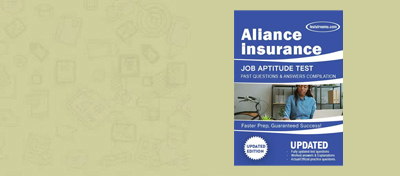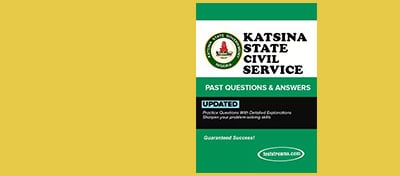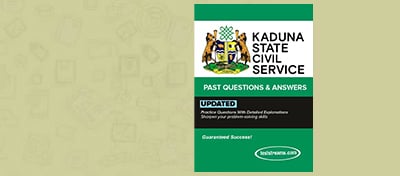Alliance Insurance Aptitude Test Past Questions and Answers- [Free PDF Download]
Securing a career in the competitive world of insurance requires more than just a resume and a firm handshake. It demands a thorough understanding of the industry, sharp analytical skills, and the ability to solve complex problems on the spot. One of the crucial steps in the hiring process at Alliance Insurance, a prominent player in the insurance sector, is the aptitude test. In this blog post, we’ll delve into the significance of Alliance Insurance’s aptitude test, explore the benefits of practicing with past questions and answers, and provide insights into how you can prepare effectively to crack the code and stand out from the crowd.
The Importance of the Alliance Insurance Aptitude Test
Before delving into the specifics of the aptitude test, let’s understand why it holds such significance in the hiring process. Alliance Insurance, like many reputable companies, uses aptitude tests as a means to assess a candidate’s cognitive abilities, problem-solving skills, critical thinking, and numerical reasoning. These tests provide valuable insights into an individual’s potential to excel in the insurance field, where complex calculations, risk assessment, and decision-making are everyday challenges.
Importance of Practicing with Past Questions and Answers
Familiarity with Test Format: Practicing with past questions and answers helps you become familiar with the test’s format, types of questions, and time constraints. This familiarity reduces test anxiety and boosts your confidence on exam day.
Identifying Patterns: Alliance Insurance aptitude tests often contain recurring question patterns or concepts. By practicing with past questions, you can identify these patterns and develop effective strategies to tackle them efficiently.
Time Management: Time is a crucial factor in any aptitude test. Regular practice with past questions helps you refine your time management skills, allowing you to allocate sufficient time to each question and complete the test within the given timeframe.
Skill Enhancement: Regular practice not only enhances your problem-solving skills but also improves your numerical reasoning and critical thinking abilities. These skills are essential for success in the insurance industry.
Self-Assessment: Practicing with past questions and comparing your answers with the provided solutions allows you to assess your strengths and weaknesses. This self-assessment enables you to focus your preparation efforts on areas that require improvement.
Effective Preparation Strategies
Gather Resources: Begin by collecting a comprehensive set of Alliance Insurance aptitude test past questions and answers. These can be sourced from previous candidates, online forums, or official test preparation resources.
Develop a Study Schedule: Create a study schedule that allocates sufficient time for practicing with past questions. Consistency is key, so ensure you dedicate regular intervals to your preparation.
Analyze Solutions: After attempting each question, thoroughly analyze the provided solutions. Understand the underlying concepts and techniques used to solve the problem.
Simulate Test Conditions: Mimic actual test conditions during practice sessions. Set a timer, isolate yourself from distractions, and strive to complete the questions within the allotted time.
Seek Assistance: If you encounter challenges while practicing, don’t hesitate to seek guidance from mentors, peers, or online communities. Collaborative learning can provide valuable insights and alternative problem-solving approaches.
Sample Questions And Answers For Alliance Insurance
LOGICAL REASONING
Question 1:
Question: All policyholders with comprehensive coverage receive roadside assistance. John is a policyholder with comprehensive coverage. What can you conclude?
Options:
A) John has received roadside assistance.
B) John is not a policyholder.
C) All policyholders receive roadside assistance.
D) Roadside assistance is not available.
Answer: A) John has received roadside assistance.
Question 2:
Question: If all insurance agents are licensed and Maria is a licensed insurance agent, what can you infer about Maria?
Options:
A) Maria is an insurance agent.
B) Maria is unlicensed.
C) All licensed individuals are insurance agents.
D) Maria is an accountant.
Answer: A) Maria is an insurance agent.
Question 3:
Question: No claims without evidence will be approved. John’s claim was approved. What can you conclude?
Options:
A) John provided evidence for his claim.
B) John’s claim was rejected.
C) No claims were approved.
D) John has evidence.
Answer: A) John provided evidence for his claim.
Question 4:
Question: If all policies with accident coverage include medical expenses, and Jane’s policy has accident coverage, what can you infer about Jane’s policy?
Options:
A) Jane’s policy includes medical expenses.
B) Jane’s policy does not have accident coverage.
C) Jane has an expired policy.
D) All policies have accident coverage.
Answer: A) Jane’s policy includes medical expenses.
Question 5:
Question: Some policyholders have discounts. All policyholders with discounts have loyalty points. What can you conclude?
Options:
A) All policyholders have discounts.
B) Loyalty points are not offered.
C) Some policyholders have loyalty points.
D) Loyalty points are given to all customers.
Answer: C) Some policyholders have loyalty points.
Question 6:
Question: If no claims are submitted without documentation, and Maria submitted a claim, what can you infer about Maria’s claim?
Options:
A) Maria’s claim was approved.
B) Maria’s claim was rejected.
C) Maria did not submit documentation.
D) No claims were submitted.
Answer: B) Maria’s claim was rejected.
Question 7:
Question: All policies with fire coverage include property damage. Sam’s policy has property damage coverage. What can you conclude?
Options:
A) Sam’s policy covers fire damage.
B) Sam’s property is damaged.
C) No policies cover property damage.
D) Property damage is not covered.
Answer: A) Sam’s policy covers fire damage.
Question 8:
Question: Some claims with accident coverage were not approved. Mike’s claim was not approved. What can you conclude?
Options:
A) Mike’s claim had accident coverage.
B) No accident claims were approved.
C) All accident claims were approved.
D) Claims without evidence were approved.
Answer: A) Mike’s claim had accident coverage.
Question 9:
Question: If no policies have both fire and theft coverage, and John’s policy has fire coverage, what can you infer about theft coverage on John’s policy?
Options:
A) John’s policy has theft coverage.
B) John’s policy has no coverage.
C) All policies have theft coverage.
D) Fire coverage is not offered.
Answer: B) John’s policy has no theft coverage.
Question 10:
Question: All policies with accident coverage include towing service. Sarah’s policy does not include towing service. What can you conclude?
Options:
A) Sarah’s policy does not have accident coverage.
B) Sarah’s policy has towing service.
C) No policies have accident coverage.
D) Towing service is not offered.
Answer: A) Sarah’s policy does not have accident coverage.
VERBAL REASONING
Question 1:
Statement: Effective communication is vital in the insurance industry.
Which of the following statements can be inferred?
A) Effective communication is not important in any industry.
B) Communication skills are not needed for insurance professionals.
C) Effective communication is necessary only for sales representatives.
D) Effective communication is crucial for insurance professionals.
Answer: D) Effective communication is crucial for insurance professionals.
Question 2:
Statement: The insurance company offers a range of coverage options to meet diverse needs.
What can you infer from the statement?
A) The insurance company only offers one type of coverage.
B) Diverse needs are not a consideration for the insurance company.
C) The insurance company offers a variety of coverage options.
D) The insurance company only serves a specific type of customer.
Answer: C) The insurance company offers a variety of coverage options.
Question 3:
Statement: Timeliness is essential when filing an insurance claim.
What does the statement imply?
A) Filing an insurance claim should be delayed.
B) Insurance claims are never timely.
C) Timeliness is not a concern in insurance claims.
D) Filing an insurance claim promptly is important.
Answer: D) Filing an insurance claim promptly is important.
Question 4:
Statement: Our dedicated team ensures customer satisfaction at every step.
What can be concluded from the statement?
A) Customer satisfaction is not a priority.
B) The team is not dedicated.
C) Customer satisfaction is a key focus for the team.
D) The team is focused on cost-cutting.
Answer: C) Customer satisfaction is a key focus for the team.
Question 5:
Statement: Insurance policies provide financial protection against unforeseen events.
Which of the following is a valid inference?
A) Unforeseen events are always positive.
B) Insurance policies guarantee wealth accumulation.
C) Financial protection is unnecessary.
D) Insurance policies offer safeguards for unexpected situations.
Answer: D) Insurance policies offer safeguards for unexpected situations.
Question 6:
Statement: Our company values integrity and transparency in all interactions.
What does the statement suggest?
A) Integrity and transparency are not important values.
B) Interactions should be dishonest and opaque.
C) The company emphasizes honesty and openness.
D) The company focuses solely on profit.
Answer: C) The company emphasizes honesty and openness.
Question 7:
Statement: Insurance claims must be supported by accurate documentation.
What can be inferred from the statement?
A) Documentation is not required for insurance claims.
B) Claims can be approved without any evidence.
C) Documentation is an essential part of processing insurance claims.
D) Documentation is irrelevant to the insurance industry.
Answer: C) Documentation is an essential part of processing insurance claims.
Question 8:
Statement: Our policies are tailored to meet individual client needs.
What can you deduce from the statement?
A) All clients have identical needs.
B) Tailored policies are not effective.
C) Individual client needs are considered when designing policies.
D) Policies are only designed for corporate clients.
Answer: C) Individual client needs are considered when designing policies.
Question 9:
Statement: The insurance industry is subject to regulatory guidelines for consumer protection.
Which inference can be drawn from the statement?
A) Regulatory guidelines are not relevant in the insurance industry.
B) Consumer protection is not a concern in the insurance industry.
C) The insurance industry operates without any rules.
D) Regulatory guidelines ensure consumer protection in the insurance industry.
Answer: D) Regulatory guidelines ensure consumer protection in the insurance industry.
Question 10:
Statement: Our customer-centric approach ensures a positive experience for policyholders.
What can be concluded from the statement?
A) Customers are not important in the insurance industry.
B) Positive experiences are irrelevant to policyholders.
C) Policyholders are only interested in profits.
D) The company prioritizes a positive experience for policyholders.
Answer: D) The company prioritizes a positive experience for policyholders.
![Alliance Insurance Aptitude Test Past Questions and Answers- [Free PDF Download]](https://teststreams.com/wp-content/uploads/2020/02/Aliance-insurance-1.jpg)




